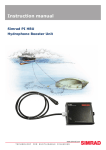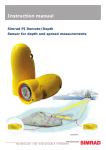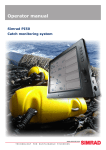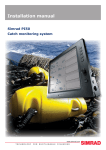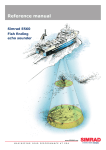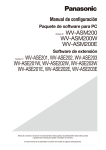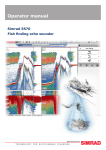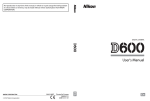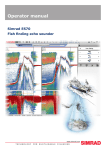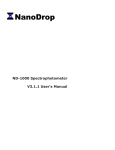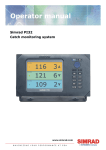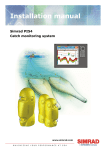Download Simrad PI SEINESOUNDER - REV D Instruction manual
Transcript
Instruction manual Simrad PI SeineSounder Combisensor for depth and height measurements www.simrad.com TECHNOLOGY FOR SUSTAINABLE FISHERIES Simrad PI SeineSounder Instruction manual This document gives you the necessary information for mounting, charging and maintaining the PI SeineSounder sensor. It also explains how to set up the PI32, PI44 and PI54 catch monitoring systems to receive and display the information provided by the sensor. 313700/D 27 June 2008 History Document number: 313700 / ISBN-10: 82-8066-091-7 / ISBN-13: 978-82-8066-091-6 Rev.A 26 June 2007 Original release. Rev.B 9 October 2007 Only minor corrections to the text. Table with default communication channels and update rates modified with new sensors. Rev.C 28 February 2008 Document updated to comply with new PI44/54 MMI Software version 0.47. Rev.D 26 June 2008 Only minor changes. Table with default communication channels and update rates modified with new sensors. Document also valid for PI44/54 MMI Software version 0.50. Copyright ©2008 Kongsberg Maritime AS The information contained in this document remains the sole property of Kongsberg Maritime AS. No part of this document may be copied or reproduced in any form or by any means, and the information contained within it is not to be communicated to a third party, without the prior written consent of Kongsberg Maritime AS. The document, or any part of it, may not be translated to any other language without the written approval from Kongsberg Maritime AS. Disclaimer Kongsberg Maritime AS endeavours to ensure that all information in this document is correct and fairly stated, but does not accept liability for any errors or omissions. Warning The equipment to which this manual applies must only be used for the purpose for which it was designed. Improper use or maintenance may cause damage to the equipment and/or injury to personnel. The user must be familiar with the contents of the appropriate manuals before attempting to install, operate or work on the equipment. Kongsberg Maritime AS disclaims any responsibility for damage or injury caused by improper installation, use or maintenance of the equipment. Support If you require maintenance on your Simrad product contact your local dealer. You can also contact us using the following address: [email protected]. If you need information about our other products, visit www.simrad.com. On our web site you will also find a list of our dealers and distributors. Instruction manual Table of contents INTRODUCTION ................................................................ 5 Purpose and applications ..........................................................................................5 Main parts identification...........................................................................................7 Information on the sensor label ................................................................................8 INSTALLATION ................................................................. 9 Mounting on a trawl .................................................................................................9 Mounting on purse seine ........................................................................................ 11 CONFIGURATION ............................................................ 14 Basic configuration.................................................................................................14 Configuration of the PI32 .......................................................................................15 Configuration of the PI44 and PI54 (SW 0.40) ......................................................16 Configuration of the PI44 and PI54 (SW 0.47) ......................................................18 About sensor configuration ....................................................................................20 Default communication channels and update rates......................................... 20 Changing a communication channel ............................................................. 20 Changing the update rate ............................................................................. 21 PI Configurator ........................................................................................... 21 DISPLAY PRESENTATIONS .............................................. 22 Numerical presentation...........................................................................................22 Graphical presentation on PI32 ..............................................................................23 Graphical presentation on PI44 and PI54...............................................................24 CHARGING AND MAINTENANCE ...................................... 27 PI SeineSounder maintenance ................................................................................27 PI SeineSounder charging ......................................................................................28 How to use the Simrad PI Charger .........................................................................28 Daily operation ........................................................................................... 29 Indicators ................................................................................................... 31 Automatic configuration.............................................................................. 31 How to use the Simrad PI MaxiCharger.................................................................32 Daily operation of the PI MaxiCharger ......................................................... 32 PI MaxiCharger indicators........................................................................... 33 313700/D 3 Simrad PI SeineSounder 4 313700/D Introduction INTRODUCTION Efficient fishery with trawl and purse seine assumes professional and adequate instrumentation on the gear. Simrad has provided professional instruments for fish finding for more than sixty years. This user manual describes installation, use and maintenance of the Simrad PI SeineSounder when put to use with the PI catch monitoring systems. Note The Simrad PI32 and the Simrad PI44 and PI54 systems with software version 0.40 will only accept PI SeineSounder sensors with depth range limited to 300 meters. To use 600 or 1000 m depth range, you will need PI44/54 with software version 0.47 (or later). Purpose and applications The purpose of the PI SeineSounder is to achieve accurate measurements of both the water depth and the height above the seabed with a single sensor. The PI SeineSounder thus contains both a pressure sensor to measure the water depth, and an echo sounder with two transducers to measure the height above the seabed. The results from these measurements are transmitted by acoustic signals to the PI catch monitoring system mounted on the vessel. The PI SeineSounder has been developed to be used on both bottom and pelagic trawls and on purse and Danish seiners. The sensor must be installed in two different ways depending on the application: • Trawl: Horizontally behind the headrope • Seine: Vertically below the footrope In order to make possible these two applications and mounting methods, the echo sounder inside the sensor has been equipped with two transducers. By means of a “sensor key” you can easily define which transducer to use. Provided with the sensor is a “gift box” with two sensor keys. These are two special bolts, and by means of magnetism inside the bolts, these will select which echo sounder transducer to use. The bolts will also act as water detectors, and that means that they will slowly disintegrate. When you mount the sensor on a trawl or a purse seine, it is therefore important that you use the correct key: • Trawl: Use the short bolt • Purse seine: Use the long bolt 313700/D 5 Simrad PI SeineSounder Figure 1 A From its position on the top of the trawl, the sensor measures the depth from the sea surface B The sensor also measures the height above the seabed. Figure 2 6 The PI SeineSounder in use on a pelagic trawl The PI SeineSounder in use on a purse seine A From its position at the bottom of the purse seine, the sensor measures the depth from the sea surface B The sensor also measures the height above the seabed. 313700/D Introduction Main parts identification Observe the illustration below for identification of the main parts of the PI SeineSounder. Figure 3 313700/D PI SeineSounder A Negative charging and fastening lug B Positive charging and fastening lug C Communication link D Location of sensor lamp E Sensor “key” and water switch sensor F Echo sounder transducer for trawl G Echo sounder transducer for purse seine H Depth sensor 7 Simrad PI SeineSounder Information on the sensor label The sensor label provides the following information. Figure 4 A The PI SeineSounder sensor label Channel identification. You must write down the two channels currently used by the sensor to communicate with the PI system. B This information identifies the sensor type. Three types are available: • PI-ND300: PI SeineSounder for maximum depth 300 m • PI-ND600: PI SeineSounder for maximum depth 600 m • PI-ND1000: PI SeineSounder for maximum depth 1000 m 8 C Spare part order number. D Opening for the water to access the pressure sensor. E Sensor “key” and water switch sensor 313700/D Installation INSTALLATION The PI SeineSounder has been developed to be used on both bottom and pelagic trawls and on purse and Danish seiners. It is important that you understand the two different ways of installation. • Trawl: Horizontally behind the headrope • Seine: Vertically below the footrope Note Remove the sensor from the gear before it passes through the power block. Ensure that mounting material attached to the charging lugs do not form an electrical connection, as this will short the charging current. Mounting on a trawl Location Place the sensor where you wish to monitor the height. This is normally aft of the headrope at the centre of the net. Mounting Secure the two forward fastening lugs (A) using two snap hooks and rope. Then, secure the two aft fastening lugs (B) using snap hooks and strong rubber bands. This mounting places the sensor in a cradle supported on all four sides. In order to secure the sensor in place, we recommend that you assemble a bag of fine meshed net, and ties this to the trawl close to the middle of the headrope. Then, mount the sensor inside this bag. The sensor must be properly secured to prevent it from moving sideways or rotate during use. Make sure that you have best possible free view between the sensor and the bottom, and between the sensor and the vessel. 313700/D 9 Simrad PI SeineSounder Figure 5 Mounting on trawl A Rope and snap hooks B Rubber bands and snap hooks C SIMRAD imprint on the sensor must point up! D Reverse side of sensor E Echo sounder transducer must point towards the bottom! Note Ensure that you mount the sensor with the reverse side (D) and the echo sounder transducer (E) pointing towards the bottom! The SIMRAD print on the sensor (C) must point up towards the water surface! REMEMBER: On trawl, use the short key bolt! 10 313700/D Installation Mounting on purse seine Location When you mount the sensor on the gear, choose the location where you wish to monitor depth and height. This is normally below the footrope. In order to secure a stable communication with the vessel, and to measure the height, it is very important that the sensor is allowed to hang freely with the top end pointing towards the surface during shooting and pursing. Installation on a purse seine Attach the sensor to a standard purse ring with two separate chains (A). Mount one end of each chain to a common snap hook (B), and secure the hook on the footrope. Mount the other end of each chain to one of the sensor’s lower lugs using two sturdy quick links. Mount a safety wire (C) between one of the sensor’s lower lugs and anywhere on the net except on the footrope. Make sure that security line does not prevent the sensor from hanging freely! Note You must make sure that the sensor is mounted vertically with its rear end pointing towards the seabed. Unless the top end of the sensor points towards the surface, you may loose the communication link. REMEMBER: On purse seine, use the long key bolt! 313700/D 11 Simrad PI SeineSounder Figure 6 12 Installation on a purse seine A Two chains. One end of each chain is mounted on a common snap hook, while the other end of each chain is secured to one of the sensor’s lower lugs using a sturdy quick link. Make sure that the chains are not too long! B Large snap hook C Safety line with “C” links at the upper end (D) and a sturdy quick link on the sensor’s lower lug. D The “C” link can be mounted several places, but NOT on the footrope. 313700/D Installation Installation on a tuna purse The sensor must not be attached to the footrope wire, but to the footrope chain. Use a safety wire in addition in case the sensor is ripped off the net. Figure 7 313700/D Installation on a tuna purse 13 Simrad PI SeineSounder CONFIGURATION In order to allow the information from the PI SeineSounder sensor to be accepted and understood by the PI catch monitoring system, the PI receiver must be set up correctly. This means that you must tell the receiver that the sensor exists by entering the sensor type, communication channels and update rate. For more detailed information about the settings and parameters, refer to the relevant operator and/or reference manuals. Note The PI SeineSounder sensor is a “dual” sensor. This means that it will occupy two channels on your PI system! Upon delivery, all PI SeineSounder sensors are set up with factory default channels and update rates. Refer to the table in section About sensor configuration on page 20. Note The sensor and the PI system setup must correspond, otherwise the communication will not work. To change the sensor setup (channel selection and update rate), use the PI Configurator utility. See PI Configurator on page 21. Basic configuration Observe the following basic settings: • When you put the PI SeineSounder to use, you must set it up with one unique sensor number with two measurements. Only one update rate can be chosen, this is common for both measurements. The channel numbers are defined individually for the two measurements. Both the update rate and the channel numbers must be chosen according to the sensor’s configuration. Write down this configuration for future reference. For default settings, refer to the table in section About sensor configuration on page 20. • On the receiver, the Interference filter must be switched on. Set it to Level 9 if you have noise problems from other hydroacoustic sources. Note that this filters will influence the signal spectrum shown in the Status display. • We recommend that you set the Sensor filter to Light. 14 313700/D Configuration Configuration of the PI32 This procedure explains how to set up the PI32 catch monitoring system to access the information provided by the PI SeineSounder sensor. For more detailed information about the PI32 settings and parameters, refer to the PI32 Operator manual. The PI32 will only accept PI SeineSounder sensors set up for maximum 300 meters depth. Note In order to set up the PI system you must know what kind of sensors you have, which communication channels they use, and how often they communicate (the update rate). You need this information before you start the setup process. Do not carry out sensor setup unless absolutely necessary. We recommend that you use the form at the beginning of the PI32 Operator manual to write down the sensors you have and their respective communication channels and update rates. Figure 8 PI SeineSounder setup example, PI32 This example shows how the PI32 is set up to receive information from the PI SeineSounder sensor. Standard communication channels and update rates are used. How to access the Sensor Setup menu 1 2 3 Press the MENU button to open the main menu. On the Setup menu, select Sensor setup. Press the ENT button to allow for changes, and then the same button one more time to accept the warning. • You must now use the circular navigation button to move the cursor between the parameters, and the + and - buttons to select values. How to set up depth readings on PI32 1 2 3 4 313700/D Choose an available sensor; 1, 2 or 3. Define the sensor type (by default None) to Single. Set Update to the correct update rate. Set Measure to the chosen sensor type Spread. 15 Simrad PI SeineSounder Note If you have an older software version on your PI32, you must select sensor type “Spread” even though you are going to read depth information from the PI SeineSounder sensor. 5 Set the communication Channel to its correct value. How to set up height readings on PI32 1 Choose an available sensor; 1, 2 or 3. 2 Define the sensor type (by default None) to Single. 3 Set Update to the correct update rate. 4 Set Measure to the chosen sensor type Height. 5 Set the communication Channel to its correct value. Configuration of the PI44 and PI54 (SW 0.40) This procedure explains how to set up the PI44 and PI54 catch monitoring systems to access the information provided by the PI SeineSounder sensor. For more detailed information about the settings and parameters, refer to the relevant operator and/or reference manual(s). Note that this PI44 and PI54 software version will only accept PI SeineSounder sensors set up for maximum 300 meters depth. Note This procedure is only applicable if you have installed MMI software 0.40 on your PI44/54 Operating Unit. To find out, open the Status Display. We recommend that you use the form at the beginning of the PI44 or PI54 operator and/or reference manual to write down the sensors you have and their respective communication channels and update rates. Note In order to set up the PI system you must know what kind of sensors you have, which communication channels they use, and how often they communicate (the update rate). You need this information before you start the setup process. Do not carry out sensor setup unless absolutely necessary. 16 313700/D Configuration Figure 9 PI SeineSounder setup example, PI44/PI54 SW 0.40 This example shows how the PI44 (or PI54) running MMI software version 0.40 is set up to receive information from a PI SeineSounder sensor. Standard communication channels and update rates are used. How to access the Setup menu 1 Press the MENU button to open the main menu. 2 On the Setup menu, select Sensor setup. 3 Press the ENT button to allow for changes, and then the same button one more time to accept the warning. How to set up the depth readings 1 Choose an available sensor; 1 to 6. 2 Define the sensor type (by default None) to Single. 3 Set Update to the correct update rate. 4 Set Measure to the chosen sensor type Spread. Note If you have the MMI SW 0.40 software version on your PI44 or PI54 Operator Unit, you must select sensor type “Spread” even though you are going to read depth information from the PI SeineSounder sensor 5 313700/D Set the communication Channel to its correct value. 17 Simrad PI SeineSounder How to set up height readings 1 Choose an available sensor; 1 to 6. 2 Define the sensor type (by default None) to Single. 3 Set Update to the correct update rate. 4 Set Measure to the chosen sensor type Height. 5 Set the communication Channel to its correct value. Configuration of the PI44 and PI54 (SW 0.47) This procedure explains how to set up the PI44 and PI54 catch monitoring systems to access the information provided by the PI SeineSounder sensor. For more detailed information about the settings and parameters, refer to the relevant operator and/or reference manual(s). Note This procedure is only applicable if you have installed MMI software 0.47 or later on your PI44/54 Operating Unit. To find out, open the Status Display. We recommend that you use the form at the beginning of the PI44 or PI54 operator and/or reference manual to write down the sensors you have and their respective communication channels and update rates. Note In order to set up the PI system you must know what kind of sensors you have, which communication channels they use, and how often they communicate (the update rate). You need this information before you start the setup process. Do not carry out sensor setup unless absolutely necessary. 18 313700/D Configuration Figure 10 (or later) PI SeineSounder setup example, PI44/PI54 SW 0.47 This example shows how the PI44 (or PI54) running MMI software version 0.47 or later is set up to receive information from a PI SeineSounder sensor. Standard communication channels and update rates are used. How to access the Setup menu 1 Press the MENU button to open the main menu. 2 On the Setup menu, select Sensor setup. 3 Press the ENT button to allow for changes, and then the same button one more time to accept the warning. How to set up the depth and height readings 313700/D 1 To reset the unit, set all six sensors to default sensor type None. 2 Choose the sensor input you wish to use for the PI SeineSounder; 1 to 6. 3 Define the sensor type (by default None) to Dual. 4 Set Update to the correct update rate. 5 Set Measure 1 to the chosen sensor type Depth 300M, Depth 600M or Depth 1000M depending on the depth rating on your PI SeineSounder. 6 Set the communication Channel to its correct value. 7 Set Measure 2 to the chosen sensor type Height. 8 Set the communication Channel to its correct value. 9 Press the ENT button to save the changes and exit. 19 Simrad PI SeineSounder About sensor configuration All sensors are provided from Simrad with predefined communication channels and update rates. Default communication channels and update rates See the table below for the initial values for the communication channels and update rates for the various sensors. Table 1 Default communication channels and update rates Sensor PI Bottom Contact PI Catch PI Depth PI Height PI Remote/Depth PI Spread PI Spread/Depth PI Twin Spread PI Temperature PI Geometry PI SeineSounder Com.channel(s) 6 4 Depth 300M: 16 Depth 600M: 12 Depth 1000M: 10 14 Depth 300M: 11 Depth 600M: 15 Depth 1000M: 13 2 Depth 300M: 16 Depth 600M: 12 Depth 1000M: 10 Spread: 2 2 and 7 8 1 and 5 Depth 300M: 5 Depth 600M: 9 Depth 1000M: 1 Height: 14 Update rate Normal Normal Fast Fast Fast Fast Fast Fast Fast Fast Fast Changing a communication channel It may be required to change one or more communication channels, and there may be many reasons for this. • You have more than one of each sensor. For example, if you have three temperature sensors, they MUST communicate on three different channels. • Other vessels near your use the same PI catch monitoring system (or a similar), and they have one or more of their sensors set up to the same communication channels as you have. This will create interference, as you will "read" each others sensors. 20 313700/D Configuration • If your sensors are set up to use communication channels too close to each other (for example, you have chosen channels 4, 5 and 6), this will limit the vessel’s speed. The reason for this is the Doppler effect. If the speed is too high, the Doppler will cause the transmission frequencies to change so much that they overlap, and this will create interference. The PI catch monitoring system will provide a warning if this is about to happen! You must then either change to other communication channels further apart, or reduce the maximum shooting speed. • If you operate at the maximum range of the sensors, you may be able to increase this range slightly if you use lower communication channels. This is because the lower communication channels use lower transmission frequencies. All sensors are provided from Simrad with a default communication channel. In some cases you may find that the chosen channel does not suit your operational needs, for example if you have more than one sensor of any given type. This is a decision you have to make depending on how many sensors you use, and how many of these that are identical. Changing the update rate It may be required to change the update rate on a sensor, that is how often it sends information back to the PI catch monitoring system. A high update rate will give frequent information updates, but the sensor will use more battery power. If you need your batteries to last as long as possible, you must consider lowering the update rate. • A low update rate will provide you with fewer information updates, but the battery will last very long. • A high update rate will give you frequent information updates, but the battery will run out faster. All sensors are provided from Simrad with a default update rate setting. In some cases you may find that this update rate does not suit your operational needs. This is a decision you have to make depending on the local fishing conditions. PI Configurator Simrad has developed a dedicated computer utility to change the sensor configurations. By means of an ordinary desktop computer and a few special cables you can do this job yourself. If you do not require frequent configurations, you can also contact you local dealer for assistance. Contact the dealer for more information. 313700/D 21 Simrad PI SeineSounder DISPLAY PRESENTATIONS The information provided by the PI SeineSounder sensor is shown on the PI catch monitoring system’s colour display. Two presentations are available: • Numerical presentation • Graphical presentation with or without echogram Numerical presentation The numerical presentation of the PI SeineSounder data is automatically shown in the relevant display modes. Since this is a “dual” sensor two rectangles are used. Figure 11 Numerical presentation, example A Sensor identification B Unit of measurement C Depth D Depth change/minute E Arrow indicates that the depth is increasing F Visual alarm G Sensor transmission indicator H Interference warning I Height J Height change/minute K Arrows pointing “out” means that the height is increasing, arrows pointing “in” means that height is decreasing On the PI display, you must use two channels to receive the information from the PI SeineSounder. The depth and height values are then shown in the numeric display. If the height or depth is increasing or decreasing, this is shown with two arrows 22 313700/D Display presentations and the variation in meters per minute. You can also see the depth and height changes as a function of time in a graphical presentation. When the readings are stable, the digits are shown in black colour. If the contact is lost, the characters *** are shown in grey. If the height is out of range, the display shows: ???. Graphical presentation on PI32 This section contains a procedure to explain how you can set up the PI32 to show you a graphical presentation of the PI SeineSounder data providing depth- and height markers. Figure 12 Graphical presentation on PI32 The purpose of the depth- and height markers on the graphical presentation is to keep an eye on how deep and how high above the seabed the gear is situated. The height sensor in the PI SeineSounder measures the distance from the seabed and up to the sensor, while the depth sensor measures the distance from the sea surface and down. 1 Identify the sensor you wish to use, and make sure that the sensor is connected to the PI32 with correct communication channels and update rates. 2 Ensure that you have a graphical presentation active on your PI unit. 3 Press theENT button to open the Graphic setup menu. • The Marker line parameter allows you to switch the marker lines on or off for sensors S1, S2 and S3. 313700/D 23 Simrad PI SeineSounder 4 Use the Marker line parameter to switch the requested marker line(s) On. 5 Enter the requested values for the marker line Marker line thickness and Marker line delay. • Marker line thickness: Use this parameter to control the thickness (in pixels) of the marker line(s). • Marker line delay: The echo sounder information is provided by the transducer located below the vessel’s hull. The sensor is however located on the gear, and may be position several hundred meters behind the vessel. In order to compensate for this physical distance you can add the Marker line delay. You must calculate this delay based on the vessel’s speed, the distance from the aft stern to the gear, and the current depth of the gear. 6 Press the ENT button to save the chosen parameters and return to the graphical presentation. The depth- and height marker lines are shown in the graphical presentation using solid lines and the same colours as the background in the numerical presentation. In order to read the accurate depth you can observe the depth scale on the right hand side, or read the value in the numerical presentation. Graphical presentation on PI44 and PI54 This section contains a procedure to explain how you can set up the PI44 and PI54 to show you a graphical presentation of the PI SeineSounder data providing depth- and height markers. 24 313700/D Display presentations Figure 13 Graphical presentation on PI44/PI54 The purpose of the depth- and height markers on the graphical presentation is to keep an eye on how deep and how high above the seabed the gear is situated. The height sensor in the PI SeineSounder measures the distance from the seabed and up to the sensor, while the depth sensor measures the distance from the sea surface and down. 1 Identify the sensor you wish to use, and make sure that the sensor is connected to the PI system with correct communication channels and update rates. 2 Ensure that you have a graphical presentation active on your PI system. 3 Press the ADJ button to open the Graphic setup menu. 4 Press the GAIN+ button repeatedly to reach the Marker line dialogue. 5 Observe the list of sensors that appear. Only those sensors that can provide a marker line are listed. 6 For every sensor (depth and height) that are used, set Auto to On. • This allows the PI unit to use the Trawl Calculator to estimate the correct time delay. (This is not applicable for purse seiners.) • If you wish to calculate the delay yourself, set Auto to Off. You must then enter the calculated value into the Delay column. 7 Enter requested value for Width. 313700/D 25 Simrad PI SeineSounder • Use this parameter to control the thickness (in pixels) of the marker line(s). 8 For every marker line, set Show to On. 9 If you wish to see the marker lines in the expanded views (bottom expansion, zoom and phased range), set Sensor marker in expansion to On. 10 If you wish the PI system to draw a thin white line over and under the marker lines, sett Marker white zone to On. 11 If you wish to see the height marker only in expanded views, set Height marker in main echogram to Off.. 12 Select requested Height reference. You have three alternatives: 1 On a purse seine, you can set up the system to show you the actual difference between the depth and height values. These should never be 0, because that would mean that the footrope is touching the bottom. To monitor this, set Height reference to Depth. 2 The height sensor measures the distance from the headrope to the bottom. If you use the echo sounder in the PI system, set Height reference to Bottom, and the height marker will follow the bottom contour. With correct time delay you will then see the trawl in “true motion”. 3 If you can not use the PI echo sounder, set Height reference to Surface. The height is now shown using 0 m depth as reference. The distance from the 0 meter line and down to the marker line is then the current height of the gear. 13 Press the ENT button to save the chosen parameters and return to the graphical presentation. 26 313700/D Charging and maintenance CHARGING AND MAINTENANCE This chapter explains how you shall recharge the battery in the PI SeineSounder sensor, and how you shall best maintain the sensor. PI SeineSounder maintenance Once installed and put to use, the sensor will automatically be switched on once the water switch is activated. After an initial start-up, the sensor starts transmission of the measured data it collects. When the sensor is not in use, check that the sensor lamp is not flashing, as this indicates that the sensor is active and discharging its batteries. In this case, wash the sensor in fresh water. All sensors are equipped with a water switch, and two different types are used. If your sensor is equipped with a sacrificial brass screw, observe the following procedure for replacement. 1 Turn the sensor upside down, and locate the brass screw. 2 Inspect the screw for wear and tear. 3 If replacement is required, locate a new screw. Before a new screw is inserted, Aqua Shield (or a similar underwater lubricant) must be applied. Due to the size of the tube, we recommend that the grease is applied from a syringe. 4 Apply Aqua Shield to the screw threads. 5 Insert the screw, mount firmly, but not too hard. Use maximum torque 1.5 NM A pack with ten screws and a tube of Aqua Shield can be ordered from Simrad as a spare parts kit. Aqua Shield is manufactured by D.A.Stuart, Warrenville, Illinois, USA. Visit www.d-a-stuart.com. No other maintenance of the sensor is required. Note You must never attempt to open the sensor. There are no user serviceable parts inside, and you may easily cause a leak. 313700/D 27 Simrad PI SeineSounder PI SeineSounder charging The PI SeineSounder sensor must be charged between operation. The battery lifetime depends on the update rate you have chosen. Note To charge the PI SeineSounder sensor, use the Simrad PI Charger or the Simrad PI MaxiCharger. Table 2 Battery lifetime for the PI SeineSounder sensor Update rate Approximate lifetime between charging Fast 24 hours Normal 60 hours Slow 80 hours Optimal sensor charging temperature is from +10 to +25° C. Note Charging sensors at sub zero temperatures can create explosive gasses. Kongsberg Maritime AS assumes no liability for improper charging of sensors, or the use of chargers not specified in our sensor or charger documentation. How to use the Simrad PI Charger The Simrad PI Charger is an intelligent battery charger for fast and secure charging of all PS and PI sensors. The charger will automatically set up the correct charging current depending on the sensor type and the battery temperature. A “fuel meter” shows the status of the battery during the charge. 28 313700/D Charging and maintenance Figure 14 The PI Charger set up to charge a PI sensor Even though the PI Charger is designed for fast charging of the PI sensors, it can also charge the PS sensors, but only at normal charge rate. Daily operation Observe the following procedure for daily operation. 1 Attach the charging clamps to the sensor as follows: • Red clamp: Positive (+) fastening lug • Black clamp: Negative (–) fastening lug • On every sensor the polarity of the fastening lugs are engraved on the sensor body using + and – characters. 2 Ensure that mounting materials do not short circuit the charging lugs. • This may be ropes, wires, chains or other items that obstruct or short circuit the electrical connections. 3 When the charger is connected to the sensor, check the charger lamps. • Once connected, the charger will identify whether the sensor connected can be fast charged or not. This is shown by the yellow lamps. If the top lamp flashes rapidly, the sensor is fast charged. 313700/D 29 Simrad PI SeineSounder 4 • If your sensor can be fast charged, the charger will also check the internal temperature of the sensor. The temperature is shown on the “thermometer” on the charger’s front panel. If you charge a sensor that can not be fast charged, this “thermometer” does not work. Observe the charge times and temperature limitations! • Fast charge: The PI Charger will first recharge the sensor battery for approximately one hour to reach 70% battery capacity, then approximately three hours to reach 100% capacity. Once fully charged, a constant trickle charge will compensate for self discharging. Note Fast charging only applies to PI sensors! • Normal charge: The PI Charger will first recharge the sensor battery for 16 hours for full battery capacity. This mode applies for charging PI sensors outside specified temperature range, and for all PS sensors. • Charging must only take place within the specified temperature range. For best results, keep the ambient temperature between +10 and +25°C. Note Do not charge sensors in temperatures above +50°C or below 0°C! WARNING Charging a sensor at sub zero temperature might develop explosive gases representing a potential danger. Simrad assumes no liability for improper charging, or the use of other chargers than those approved by us. 30 313700/D Charging and maintenance Indicators A +12 to 32 Vdc connected B “Fuel meter”, the number of LEDs illuminated shows the current charging status. A complete charging cycle is indicated with all “full” battery. Charging is indicated as follows: • Fast flashing: Fast charging in progress • Slow flashing: Normal charging in progress • On/off every four seconds: Trickle charging in progress C Battery temperature indicators during fast charging of PI sensors: • Green: Battery temperature between +5 and +40°C. Fast charge is enabled. • Green and Blue: Battery temperature between 0 and +5°C. Fast charge is disabled, normal charge is used. • Green and Red: Battery temperature between +40 and +50°C. Fast charge disabled, normal charge is used. • Blue: Battery temperature is below 0°C. No charging takes place. • Red: Battery temperature is above +50°C. No charging takes place. Automatic configuration The charger communicates with the sensor at regular intervals. The fast charge cycle is controlled by data exchanged between the PI sensor and the charger, and a series of safety mechanisms controls the termination of the fast charging current. The PS sensors do not communicate with the charger. A constant charge current of 58 mA is then set up by the charger regardless of the battery temperature. 313700/D 31 Simrad PI SeineSounder How to use the Simrad PI MaxiCharger The Simrad PI MaxiCharger is a plain battery charger to be used with large PI sensors. These are: • PI Spread • PI Height • PI SeineSounder • PI Spread/Depth • PI Remote/Depth • PI Geometry WARNING Do not use the PI MaxiCharger on any other PI or PS sensors than those listed here! The large charging current may damage the battery! Figure 15 Simrad PI MaxiCharger The Simrad PI MaxiCharger is provided with a small booklet from the manufacturer (Mascot). Read this booklet before you put the charger to work! WARNING Charging a sensor at sub zero temperature might develop explosive gases representing a potential danger. Simrad assumes no liability for improper charging, or the use of other chargers than those approved by us. Daily operation of the PI MaxiCharger Observe the following procedure for daily operation. 1 Connect the charger to 230 Vac, and check that the charger lamp is lit in yellow. 32 313700/D Charging and maintenance 2 Ensure that mounting materials do not short circuit the charging lugs. • This may be ropes, wires, chains or other items that obstruct or short circuit the electrical connections. 3 Attach the charging clamps to the sensor as follows: • Red clamp: Positive (+) fastening lug • Black clamp: Negative (–) fastening lug • On every sensor the polarity of the fastening lugs are engraved on the sensor body using + and – characters. 4 When the charger is connected to the sensor, check the charger lamps. • After a few seconds, the lamp on the charger will change from yellow to orange/red. This means that fast charging is in progress. • When the battery in the sensor has reached 90% capacity the lamp will change from orange/red to green with short yellow flashes. This means that top charging is in progress. • When the battery is fully charged, the lamp turns green. Trickle charging is now active. You can safely allow trickle charging for long periods of time. PI MaxiCharger indicators The charger is only equipped with a single indicator lamp, this lamp will however change colour to show the status of the charging process. • Yellow: The charger is connected to 230 Vac, it has not been connected to the sensor, and it is ready for use. • Orange/Red: The charger is connected to a sensor, and fast charging is in progress. • Green with short yellow flashes: Top charging is in progress. • Green: Trickle charging is in progress. 313700/D 33 Simrad PI SeineSounder A trawl, 9 Applications, 5 N B Bolt LONG for purse seine, 5 SHORT for trawl, 5 C Charging, 27–28 Communication channel default values, 20 why change?, 20 Configuration, 14 PI32, 15 PI44 SW 0.40, 16 PI54 SW 0.40, 16 sensor, 20 D Default communication channels, 20 update rate, 20 Display presentation graphical PI32, 23 PI44/PI54, 24 numerical, 22 Display presentations, 22 Numerical presentation, 22 P PI Charger use, 28 PI MaxiCharger use, 32 PI32 configuration, 15 PI44 configuration SW 0.40, 16 PI54 configuration SW 0.40, 16 Presentations, 22 Procedure configuration PI32, 15 PI44 SW 0.40, 16 PI54 SW 0.40, 16 Purpose, 5 Purse seine sensor mounting, 11 S Sensor configuration, 20 Sensor key LONG for purse seine, 5 SHORT for trawl, 5 G Graphical display presentation PI32, 23 PI44/PI54, 24 I Installation, 9 purse seine, 11 trawl, 9 Introduction, 5 T Trawl sensor mounting, 9 U Update rate default values, 20 why change?, 21 W M Water detector, 5 Maintenance, 27 Mounting purse seine, 11 34 313700/D Index 313700/D 35 ISBN-10: 82-8066-091-7 ISBN-13: 978-82-8066-091-6 ©2008 Kongsberg Maritime AS








































